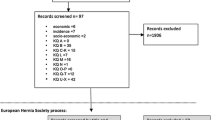Abstract
Background
The potential utility of both non-absorbable and absorbable meshes to reinforce the esophageal hiatus and prevent recurrent hernia has been investigated in observational studies and a few randomized clinical trials. Use of absorbable mesh has been associated with lesser side-effects, but the long-term safety and effectiveness are still debated. This rather scanty clinical evidence is due to heterogeneity and bias regarding the type of mesh and operation used, the modalities of follow-up, and the reporting of objective results.
Objectives
The aim of the study was to assess safety, quality of life, and recurrence-free probability after laparoscopic repair of hiatal hernia reinforced with a synthetic absorbable mesh.
Methods
Observational, retrospective, single-center cohort study. All patients with hiatal hernia who underwent laparoscopic crura repair using a biosynthetic mesh (Gore Bio A® tissue reinforcement, Flagstaff, AZ) were included. Pre- and post-operative symptoms were assessed with the GERD-HRQL questionnaire. Objective follow-up consisted of upper gastrointestinal endoscopy and barium swallow study.
Results
From September 2011 to March 2016, a total of 100 patients underwent hiatal hernia repair using a Bio-A® mesh. All surgical procedures were completed laparoscopically. Postoperative morbidity rate was 10%. All patients had a minimum follow-up of 6 months, and the median follow-up was 30 (IQR = 22) months. No mesh-related complications occurred. The incidence of recurrent hernia ≥2 cm was 9%, and eight of the nine patients had a preoperative type III hernia. The median GERD-HRQL score was significantly reduced after operation (p < 0.001). The recurrence-free probability at 1 and 5 years was, respectively, 0.99 (CI 0.97–1.00) and 0.84 (CI 0.74–0.97), and no reoperation was required. No association was found between age, BMI, hernia size, previously failed surgical repairs and hernia recurrence.
Conclusions
The use of a synthetic absorbable mesh to reinforce the esophageal hiatus is safe and appears to be effective and durable over a medium-term follow-up.





Similar content being viewed by others
References
Stylopoulos N, Rattner DW (2005) The history of hiatal hernia surgery: from Bowditch to laparoscopy. Ann Surg 241:185–193
Kaplan JA, Schecter S, Lin MYC, Rogers S, Carter JT (2015) Morbidity and mortality associated with elective or emergency paraesophageal hernia repair. JAMA Surg 150(11):1094–1096
Draaisma WA, Gooszen HG, Tournoij E, Broeders IA (2005) Controversies in paraesophageal hernia repair: a review of literature. Surg Endosc 19(10):1300–1308
Hashemi M, Peters JH, DeMeester TR et al (2000) Laparoscopic repair of large type III hiatal hernia: objective follow-up reveals high recurrence rate. J Am Coll Surg 190(5):553–560
Frantzides CT, Carlson MA, Loizides S et al (2010) Hiatal hernia repair with mesh: a survey of SAGES members. Surg Endosc 24:1017–1024
Antoniou SA, Antoniou GA, Koch OO, Pointner R, Granderath FA (2012) Lower recurrence rates after mesh-reinforced versus simple hiatal hernia repair: a meta-analysis of randomized trials. Surg Laparosc Endosc Percutan Tech 22:498–502
Stadlhuber RJ, Sherif AE, Mittal SK et al (2009) Mesh complications after prosthetic reinforcement of hiatal closure: a 28-case series. Surg Endosc 23(6):1219–1226
Kahrilas PJ, Kim HC, Pandolfino JE (2008) Approaches to the diagnosis and grading of hiatal hernia. Best Practice Res Clin Gastroenterol 22:601–616
Asti E, Bonavina L, Lombardi M, Bandera F, Secchi F, Guazzi M (2015) Reversibility of cardiopulmonary impairment after laparoscopic repair of large hiatal hernia. Int J Surg Case Rep 14:33–35
Velanovich V (1998) Comparison of generic (SF-36) vs disease-specific quality of life (GERD-HRQL) scales for gastroesophageal reflux disease. J Gastrointest Surg 2(2):141–145
R Development Core Team (2015) A language and environment for statistical computing. R Foundation for Statistical Computing, 2015. Vienna, Austria. ISBN 3-900051-07-0
Asti E, Lovece A, Bonavina L, et al (2016) Laparoscopic management of large hiatus hernia: 5-year cohort study and comparison of mesh-augmented versus standard crura repair. Surg Endosc 30:5404–5409
Wang Z, Bright T, Irvine T, Thompson SK, Devitt PG, Watson DI (2015) Outcome for asymptomatic recurrence following laparoscopic repair of very large hiatus hernia. J Gastrointest Surg 19:1385–1390
Oelschlager BK, Pellegrini CA, Hunter J et al (2006) Biologic prosthesis reduces recurrence after laparoscopic paraesophageal hernia repair: a multicenter, prospective, randomized trial. Ann Surg 244(4):481–490
Oelschlager BK, Pellegrini CA, Hunter JG et al (2011) Biologic prosthesis to prevent recurrence after laparoscopic paraesophageal hernia repair: long-term follow-up from a multicenter, prospective, randomized trial. J Am Coll Surg 213(4):461–468
Lidor AO, Steele KE, Stem M, Fleming RM, Schweitzer MA, Marohn MR (2015) Long-term quality of life and risk factors for recurrence after laparoscopic repair of paraesophageal hernia. JAMA Surg 150(5):424–431
Zaninotto G, Portale G, Costantini M et al (2007) Objective follow-up after laparoscopic repair of large type III hiatal hernia. Assessment of safety and durability. World J Surg 31:2177–2183
Tam V, Winger DG, Nason KS (2016) A systematic review and meta-analysis of mesh versus suture cruroplasty in laparoscopic large hiatal hernia repair. Am J Surg 21(1):226–238
Watson DI, Thompson SK, Devitt PG et al (2015) Laparoscopic repair of very large hiatus hernia with sutures vs absorbable vs non-absorbable mesh—a randomized controlled trial. Ann Surg 261:282–289
Koetje JH, Irvine T, Thompson S et al (2015) Quality of life following repair of large hiatal hernias is improved but not influenced by use of mesh: results from a randomized controlled trial. World J Surg 39(6):1465–1473
Muller-Stich BP, Kenngott HG, Gondan M et al (2015) Use of mesh in laparoscopic paraesophageal hernia repair: a meta-analysis and risk-benefit analysis. PLOS One. doi:10.1371/journal.pone.0139547
Author information
Authors and Affiliations
Corresponding author
Ethics declarations
Ethical approval
All procedures involved in studies involving human participants were in accordance with the ethical standards of the institutional and/or national research committee and with the 1964 Helsinki declaration and its later amendments or comparable ethical standards.
Conflict of interest
EA, AS, GB, AL, PM, and LB declare no conflict of interest.
Rights and permissions
About this article
Cite this article
Asti, E., Sironi, A., Bonitta, G. et al. Crura augmentation with Bio-A® mesh for laparoscopic repair of hiatal hernia: single-institution experience with 100 consecutive patients. Hernia 21, 623–628 (2017). https://doi.org/10.1007/s10029-017-1603-1
Received:
Accepted:
Published:
Issue Date:
DOI: https://doi.org/10.1007/s10029-017-1603-1




